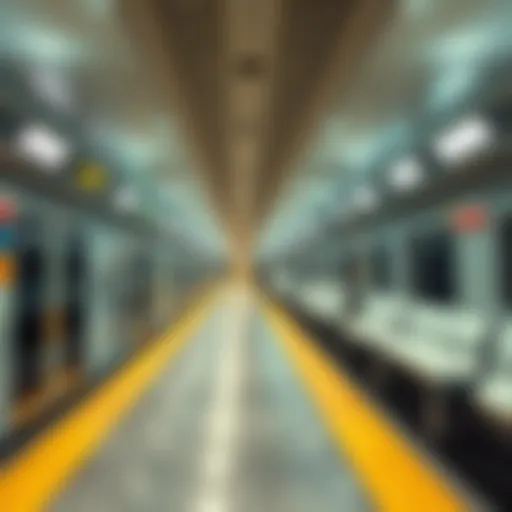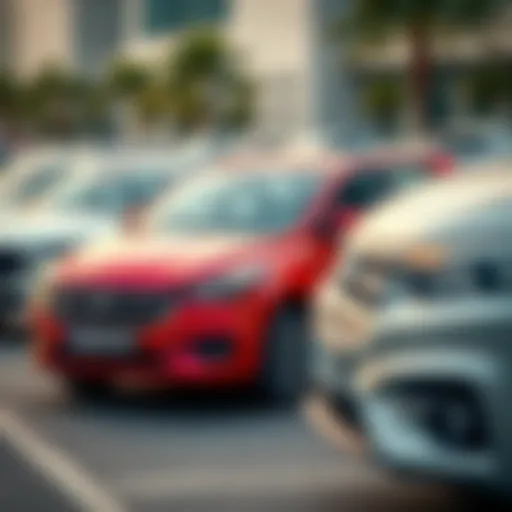Dubai Metro Schedule: Hours, Frequency, and Tips
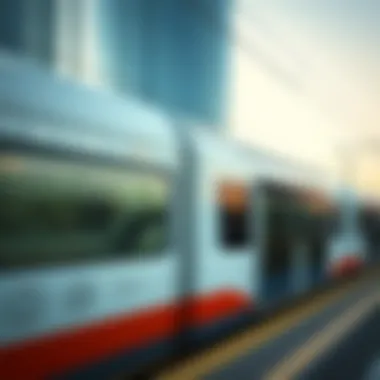
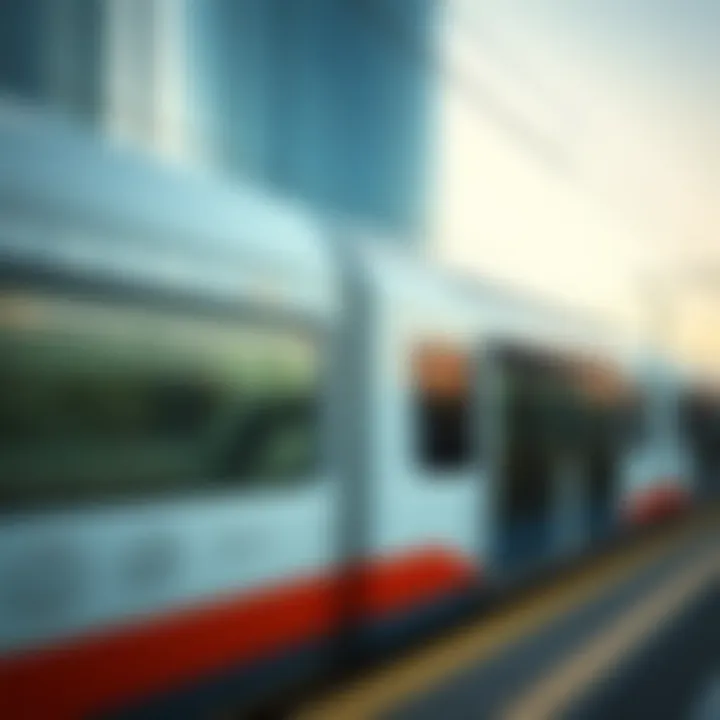
Intro
This article delves into the ins and outs of the Dubai Metro’s operational framework. From its frequent service hours to how events and peak times can affect your travels, we’ve got you covered. We are here to dissect the metro’s schedule in a way that makes it easy for residents, visitors, and commuters alike to plan their trips without a hitch.
Whether you're a local or a traveler, understanding the schedule goes beyond just checking times—it's about enhancing your experience in this vibrant city. With that in mind, let’s explore the factors that influence the Dubai Metro and how they might affect your next journey.
Market Trends
Current Real Estate Landscape
As cities evolve, so does their infrastructure. In Dubai, the relationship between the Metro’s schedule and the real estate market offers a unique insight into urban development. The Metro has catalyzed growth in certain areas, making them more attractive for residential and commercial investments. Areas like Dubai Marina and Downtown Dubai have witnessed significant property developments, primarily due to their proximity to Metro stations. Investors are keenly aware that the availability of public transport often corresponds with a rise in property values.
Property Price Trends
We can take a closer look at how the real estate market reflects the rhythm of the metro. In neighborhoods such as Al Nahda and Jumeirah Village Circle, property prices have seen fluctuations directly correlated with changes in Metro services. When stations are announced or opened, there's a noticeable uptick in demand and prices. Conversely, if service reliability wanes or operational hours shift, it might lead investors to rethink their priorities.
- New Developments: Flats and commercial spaces near existing stations experience rapid appreciation, sometimes dubbing these areas as 'golden zones.'
- Long-term Investments: Properties further from Metro stations can still yield high returns as the network expands.
Understanding these dynamics can put investors one step ahead in making choices that align with market trends.
Finale
The interlinking of the Dubai Metro schedule with real estate trends offers valuable perspectives for investors, homeowners, and anyone interested in the urban fabric of Dubai. As the city continues to grow, knowing when and where to invest becomes even more crucial, highlighting the metro's pivotal role in shaping future urban landscapes. Analyzing these trends can lead to informed decisions that stand the test of time.
"Investing is not just about the numbers; it’s about understanding the bigger picture, which includes how infrastructure like the Metro shapes our environment."
To stay updated, resources like Dubai Land Department and real estate forums on Reddit can provide ongoing insights into the property market and its relationship to public transport.
Overview of the Dubai Metro
The Dubai Metro is a cornerstone of urban transport in a rapidly evolving metropolis. As one of the most advanced metro systems in the world, it not only serves to alleviate traffic woes but also enhances the quality of life for residents and visitors alike. This overview will delve into significant elements that underline the importance of the Dubai Metro, including its efficiency, user-friendly accessibility, and integration with other transportation networks.
Preamble to Dubai Metro
Launched in 2009, the Dubai Metro spans over 75 kilometers, connecting various neighborhoods and key districts throughout the city. With its two main lines—the Red and Green line—it has become an indispensable travel option for millions. Not just a mode of transportation, the metro encapsulates Dubai's ambition to create a sustainable future while reducing carbon emissions. The utilization of advanced technology, including driverless trains, reflects the city's forward-thinking approach to infrastructure and urban mobility.
The experience of riding the metro isn’t just functional; it’s designed to be enjoyable too, with clean stations, automated announcements, and real-time updates. There’s something remarkably efficient about such a large system working seamlessly to keep a whole city in motion.
Significance in Urban Transport
The significance of the Dubai Metro extends beyond mere convenience. It plays a pivotal role in shaping the urban landscape and influencing real estate values and business opportunities throughout Dubai. By making commuting easier and faster, the metro has become a catalyst for economic growth, impacting everything from tourism to local business development.
- Promotion of Public Transport: The existence of a reliable metro system encourages people to leave their cars at home, leading to a reduction in congestion and lowering the environmental footprint.
- Enhancing Property Values: Proximity to metro stations tends to raise property values, making areas more attractive to investors.
- Facilitating Tourism: The ease of access to various landmarks through the metro aids in drawing tourists, which directly positively affects the local economy.
Ultimately, the Dubai Metro stands as a testament to the city’s resolve to provide an efficient, modern, and sustainable transportation system. As such, understanding its operational framework—including schedules and frequencies—becomes essential for making the most out of this vital service.
Operating Hours of the Metro
The operation hours of the Dubai Metro represent a crucial aspect for all who rely on this efficient transport system. Understanding these hours not only helps improve travel planning but also enhances accessibility to various destinations within the city. For residents, commuters, and tourists alike, knowing when the metro is operational can make a significant difference in managing their time effectively. Additionally, the reliable scheduling enables better synchronization with other transport modes, increasing the ease of passage across the urban landscape.
Standard Operational Hours
The standard operational hours of the Dubai Metro usually run from 5:00 AM to midnight on weekdays. This extensive timeframe allows commuters to utilize the metro service conveniently. During the week, trains run at regular intervals, which can often be as frequent as every 5 to 10 minutes during peak periods.
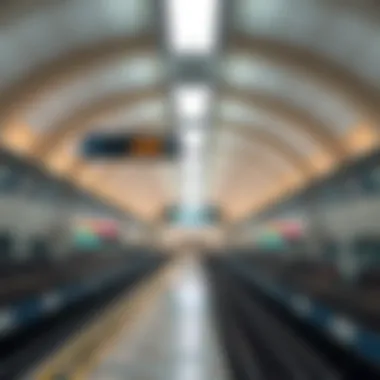
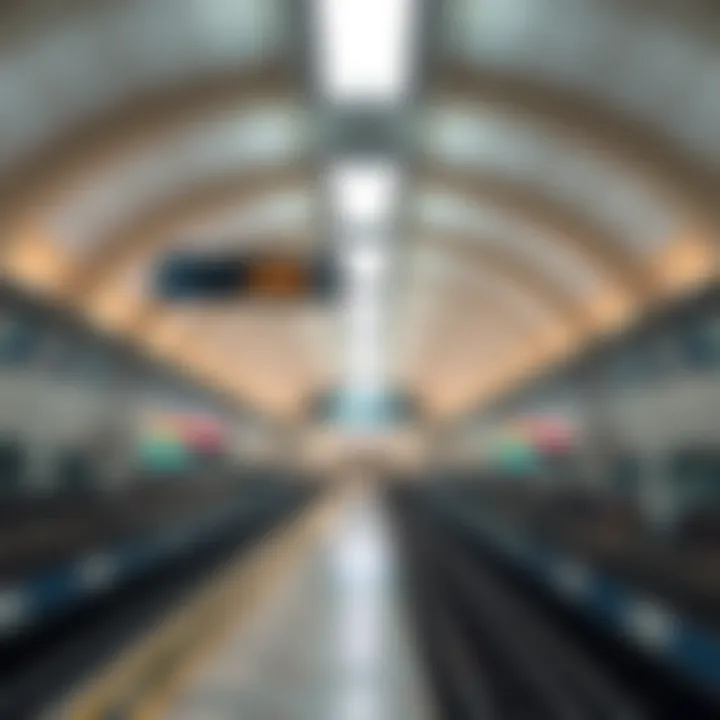
- Monday to Thursday: 5:00 AM - Midnight
- Friday: 5:00 AM - 1:00 AM of the following day
- Saturday: 5:00 AM - Midnight
- Sunday: 8:00 AM - Midnight
An important point to note is that, while these hours provide good coverage, they can vary slightly depending on specific lines, particularly during events or maintenance activities. Keeping an eye on announcements can save one from unexpected delays.
Weekend and Holiday Schedule
The weekend schedule presents slight variations, which can be particularly useful for those engaging in leisure activities around the city. On Fridays, the metro opens earlier at 5:00 AM but extends its hours until 1:00 AM on Saturday. This late-night service caters to the bustling nightlife scene that Dubai offers, allowing party-goers and late-night shoppers to travel without hassle.
During public holidays, the operating hours may similarly adjust. These changes are often announced in advance to assist riders in planning their journeys.
For example:
- Eid holidays: The metro might operate on altered schedules, allowing increased frequency of trains to accommodate the extra traffic.
- National Day: Services typically extend, reflecting the festive spirit of the day.
Understanding the weekend and holiday schedules becomes vital for those who want to take full advantage of Dubai's vibrant leisure offerings. Analysts and stakeholders might also want to keep in mind that these scheduling nuances can impact urban mobility trends and overall city traffic.
"Comprehending the operation hours of the Dubai Metro is key not just for practicality, but also for strategic urban planning."
All in all, knowing the operational hours ensures that you can confidently navigate the metro system, adjust to changes, and enjoy the best Dubai has to offer.
Frequency of Service
Frequency of service is a crucial element that defines the usability and efficiency of any public transportation system, and Dubai Metro is no exception. This section delves into how often trains run and examines the implications this has on rider experience and urban mobility. The seamless connection between various destinations hinges significantly on the adequacy of train frequency, making it a vital consideration for residents and visitors alike.
Trains Per Hour
The Dubai Metro operates with an impressive schedule, ensuring that residents and tourists alike can traverse the city efficiently. Trains generally run every 2 to 8 minutes, depending on the time of day. During peak hours, you can expect trains to be dispatched every 2 or 3 minutes. This rapid rotation is designed to manage the influx of commuters heading to work or engaging in popular leisure activities. Off-peak times see the frequency stretch a bit, with 6 to 8 minutes between trains.
It’s worth noting that the Red Line, which connects essential locations like Dubai International Airport and the Burj Khalifa, often has more frequent service than the Green Line, particularly during busy shopping seasons and holidays.
This frequency not only reduces wait times but also encourages more people to use the Metro instead of relying on cars, thus contributing to reduced traffic congestion. The reliability of service is essential for commuters who schedule their routines around these trains. Many users appreciate the predictability, allowing them to plan accordingly and minimize delays.
Impact of Peak Times
Peak times significantly influence the experience of travelers on the Dubai Metro. During weekdays, particularly in the morning and late afternoon, passengers can expect trains to be packed. This is when the local workforce commutes en masse to and from workplaces. The Dubai Roads and Transport Authority (RTA) provides real-time data through its app and other resources to inform commuters of waiting times and train occupancy.
- Highlights of Peak Times:
- Increased frequency up to every 2-3 minutes.
- Potential crowding, especially on the Red Line.
- Extended operational hours on weekends to accommodate leisure travelers.
Commuters during these busy times may need to adjust their expectations, particularly concerning space within the train. While added frequency helps, it’s essential for users to arrive slightly ahead of their planned schedule, ensuring a better experience overall.
The impact goes beyond just discomfort; it affects how smoothly the transit system operates. Delayed arrivals during peak hours can ripple through the schedule, leading to compounded wait times for subsequent passengers.
Moreover, the RTA often adjust the metro schedules based on social and economic events, ensuring that operational hours are aligned with city needs. This responsiveness is part of what makes Dubai Metro a reliable choice for navigating the vibrant city.
In summary, understanding the frequency of service provided by the Dubai Metro helps in appreciating its role in enhancing urban mobility, especially during those crunched moments of high commuter volume.
"Timely train service is the lifeblood of a vibrant city; it connects communities and supports economic growth."
For further information on train schedules and urban transport insights, you can visit resources like the RTA official website or consult urban studies available on platforms such as ResearchGate.
In light of these considerations, as you navigate Dubai’s dynamic landscape, be aware of when to catch your train to take full advantage of the metro's capabilities.
Station-Specific Timings
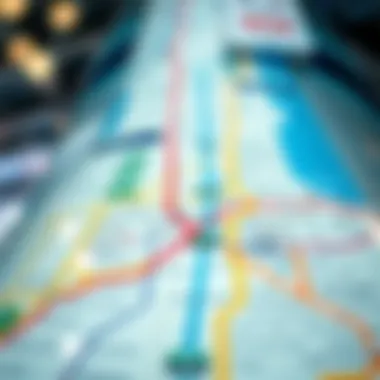
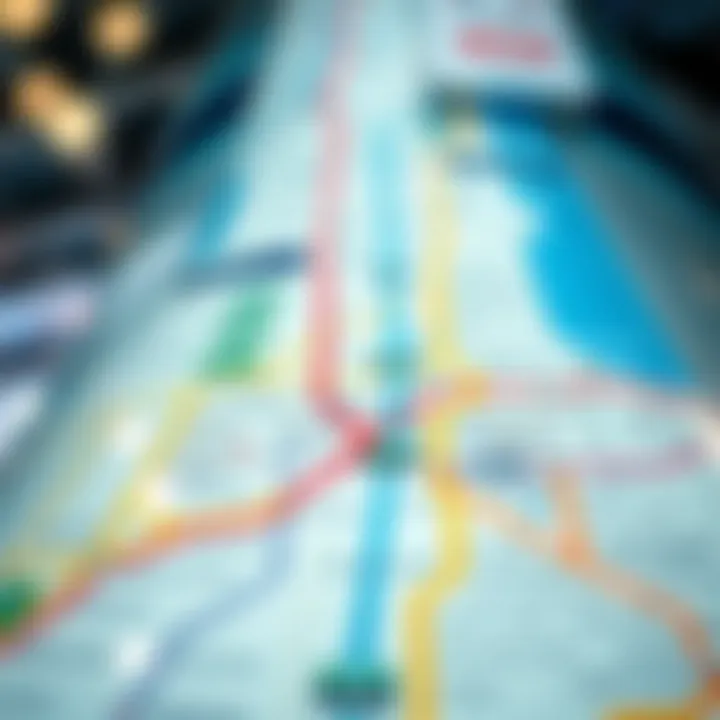
Understanding station-specific timings is crucial for anyone navigating the Dubai Metro. Each station does not simply operate under a uniform set of hours; instead, variations can occur based on factors like location, line specifics, and peak hours. This not only affects commuters but also tourists who may rely on the Metro for accessing different parts of the city. Having precise information about station timings enhances overall travel efficiency, reduces waiting time, and facilitates smoother connections with other transport modes. Therefore, knowing which stations operate when can transform the experience of using the Metro from frustrating to seamlessly organized.
Key Stations and Their Hours
Dubai Metro boasts several key stations, each with its own schedule that may vary during the week or in response to special occasions. For instance, Al Rashidiya station, primarily catering to commuters on the Red Line, operates from 5:00 AM to midnight from Saturday to Thursday, while on Fridays, the hours extend from 10:00 AM to 1:00 AM on the following day.
In contrast, Burj Khalifa/Dubai Mall station, which sees a heavy flow of tourists due to its proximity to popular landmarks, follows a slightly different timetable. It also opens at 5:00 AM but stays operational until 1:00 AM on Fridays, effectively accommodating the late-night crowd that throngs the world’s tallest building.
Another notable station is the Mall of the Emirates, enjoying a similar flexibility with extended hours on weekends. This careful structuring ensures that the most frequented stations align their hours to meet the demands of both locals and visitors, providing the much-needed ease of access.
Differences Between Lines
The Dubai Metro consists of two primary lines—the Red Line and the Green Line—each having distinct schedules. For example, during peak hours, the Red Line operates trains every 2-3 minutes, responding vigorously to the high passenger demand in the business districts and tourist hotspots. Conversely, the Green Line, which connects different neighborhoods, typically has a slightly less frequent service of every 5-7 minutes during the same time frame.
The operational hours may also diverge in terms of off-peak times. While the Red Line maintains a robust schedule throughout the day, the Green Line sometimes has shorter operational hours, impacting commuter accessibility. Such differences between the lines necessitate careful planning if one intends to switch between routes, especially during late-night travels, to avoid unnecessary delays.
Station timings are not just numbers on a board; they are the lifeline for anyone looking to navigate through the bustling urban landscape of Dubai.
In summation, understanding station-specific timings, alongside the differences between the Red and Green Lines, underscores the importance of personalized travel planning in navigating the Dubai Metro. This awareness leads to optimized routes and better overall experiences for users.
Special Events and the Metro Schedule
The interaction of Dubai Metro's schedule with special events in the city illustrates a dynamic approach to urban mobility. Major events, whether cultural, sporting, or exhibition-related, can dramatically affect not just the flow of traffic but also the bustle of the entire city. Hence, understanding how the metro accommodates these occurrences is vital for smooth navigation.
Adjustments During Major Events
When it comes to major events like the Expo 2020 or the Dubai Shopping Festival, the metro system adapts extensively. These adjustments ensure that the influx of people is managed efficiently. The operational hours often extend, and train frequencies can double, even triple, during peak times of these events. Visitors are likely to see higher train service rates, particularly during the evenings when people flock to venues.
Highlights of Adjustments During Major Events:
- Extended service hours to accommodate late-night events
- Increased frequency of trains to minimize crowding
- Special announcements and clear signage at major stations
- Coordination with event organizers for seamless transit
These measures bring about greater functionality and accessibility, allowing gatherings of thousands or even millions without turning the transport system chaotic. For instance, during the grand opening of Expo 2020, strategic shifts in operational hours were vital in helping commuters reach the venue without hassle.
To fully enjoy the offerings of these major events, one must stay informed of any scheduling changes, as well as plan ahead to ensure a stress-free journey.
Festivals and Their Impact
Festivals are another pressing element that influences the metro schedule. During significant cultural celebrations like Ramadan or the Eid festive periods, the metro tends to adjust its operations accordingly. Late-night services are often in play to accommodate celebrants heading to prayer, family gatherings, and festivities.
- During Ramadan, the metro operates for extended hours with a unique schedule that aligns with the evening Iftar meal times.
- Eid celebrations see metro stations adorned with vibrant decorations, enhancing the festive atmosphere that encourages riding.
The goal of such adaptations? To facilitate easy movement while fostering a sense of community spirit among diverse cultures that Dubai embraces. Commuters can experience an ease of access that otherwise might be severely compromised in crowded times.
For more in-depth information on public transportation and special events in Dubai, you may visit the Dubai Roads and Transport Authority at https://www.rta.ae.
Integration with Other Transport Modes
The integration of the Dubai Metro with other transportation options is a linchpin in creating a coherent public transit system. Understanding this interplay can significantly enhance the commuting experience for everyone, from daily riders to occasional tourists. The seamless connection between varied modes of transport—like buses, trams, and rideshare services—allows for fluid movement across the city, making it easier to navigate the urban landscape.
Connection with Buses and Trams
The Dubai Metro does not function in isolation; it’s part of a larger web of public transportation. The connections with buses and trams are a testament to this interface. At numerous metro stations, commuters can easily switch from rail to road, expanding their travel options dramatically.
Each metro station is typically accompanied by bus stops, ensuring that riders can hop on a bus almost immediately upon exiting. Each transit line works in tandem, helping to minimize wait times and streamline travel. Consider the exchange at the Rashidiya station, where both the metro and several Dubai bus routes converge. It’s a strategic location that connects users traveling towards the airport with those heading to central Dubai, providing a frictionless transition from the railways to the highways.
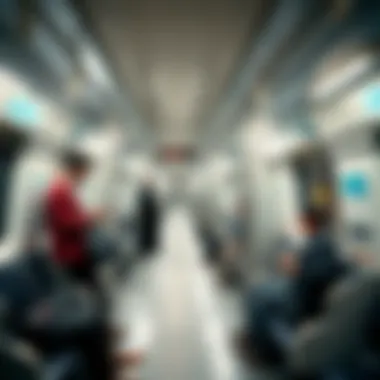

Trams, on the other hand, operate mainly along Dubai Marina and Jumeirah Beach Residence, branching out from select metro stations. At the Damac Properties station, for instance, the tram network picks up and delivers passengers heading towards the bustling shopping and dining locations nearby, further enhancing accessibility in these high-traffic areas.
Key Benefits of Bus and Tram Connections:
- Increased Coverage: Allows commuters access to fringe areas that aren’t directly served by the metro.
- Cost-Effectiveness: Many bus connections are offered at little to no additional fare when linking with the metro, promoting cost efficiency.
- Flexible Options: Commuters can mix and match modes depending on their specific destination and time requirements.
Utilizing Rideshare Services
Rideshare services like Uber and Careem have found a firm foothold in Dubai, contributing substantially to the mobility ecosystem. These services work well in tandem with the metro, offering a convenient solution for the last-mile connectivity challenge. After disembarking from the metro, riders can summon a car to take them directly to their final destination, especially in areas that might not be easily accessed by buses or trams.
While Dubai Metro covers significant parts of the city, many neighborhoods and business districts require additional transport options. The flexibility of rideshare options provides this necessary bridge.
Imagine a scenario: you’ve just finished a long day at work in the Dubai International Financial Centre. After taking the metro, a few taps through the app brings a vehicle right to your chosen exit point, able to navigate the last stretch home or to another meeting without the hassle of additional waiting or navigating through public transit.
Considerations when utilizing rideshares with the Dubai Metro:
- Cost Awareness: While convenient, frequent rideshare usage can add up. It’s wise to gauge when to use and when to opt for public transport.
- Waiting Times: Some areas may experience longer wait times during peak hours, so planning accordingly will save you from unexpected delays.
- Availability: Awareness of the rideshare policy in certain areas (there are sometimes zones from where these services can operate) is a must for successful navigation.
"Integrating the Dubai Metro with public buses, trams, and rideshare services illustrates the city's commitment to mobility and connectivity, making commuting a more comprehensive experience for everyone."
In essence, understanding how the metro interlinks with these other transport modes is essential for any traveler aiming for a laid-back yet efficient commute in Dubai. As the city continues to evolve, these integrations will only become more crucial, shaping the way residents and visitors alike navigate their daily journeys.
User Experience and Accessibility
In any urban transport system, user experience and accessibility are paramount. The Dubai Metro, recognized for its modern efficiency, not only facilitates commuter journeys but also considers the individual needs of each user. This section aims to break down the essential elements that contribute to a seamless experience, especially for newcomers to the city, along with those who require specific accommodations.
Information for First-Time Users
Navigating a new transport system can be a daunting task, especially for first-time users of the Dubai Metro. To enhance ease of access, the metro has incorporated several user-centric features.
- Metro Map: Upon entering a station, users are greeted with a comprehensive metro map outlining each line and stop. This visual aid is crucial for understanding connections and planning your journey.
- Ticket Machines: These machines accept multiple payment methods, including cash and cards. They provide instructions in various languages, accommodating a diverse user base. Another tip is to grab a Nol card at the machine; it's a smart card that can be recharged and used for travel.
- Information Desks: If users need assistance, each station is equipped with information desks staffed by knowledgeable personnel. They can address inquiries regarding routes, ticketing, and schedules.
For first-time riders, it’s advisable to check the metro schedule online before traveling. The official Roads and Transport Authority (RTA) website provides up-to-date information on operating hours, frequency, and any pending announcements.
Accessibility Features
The Dubai Metro is designed with inclusivity in mind, ensuring that all users have access to its services. From ramps to audio announcements, the system puts a good deal of consideration into various accessibility needs.
- Ramps and Elevators: Each station comes equipped with ramps and elevators, making it easier for passengers with mobility challenges, wheelchair users, and people traveling with strollers.
- Audio and Visual Aids: Train announcements are made both audibly and visually through digital displays. These features assist individuals who are hard of hearing or visually impaired in understanding stops and connections.
- Designated Seating: In addition to ramps, designated seating areas are clearly marked within each train car, ensuring that those who need extra space can travel comfortably.
- Emergency Assistance: For emergencies, users can easily locate assistance call points in case immediate help is needed.
- Website Accessibility: The official metro website considers users with disabilities, offering screen-reader-friendly content.
"Accessibility is not a privilege; it's a right. The Dubai Metro embodies this philosophy, ensuring that public transport is open to all."
In summary, the user experience aboard the Dubai Metro is made significantly more pleasing through careful planning and thoughtful design, especially for first-time users and individuals with special needs. The considerations taken show a commitment to not just efficiency but to inclusivity in urban transport.
For further insights on navigating the metro effectively, you might want to check out discussions on platforms like Reddit or browse through community posts on Facebook.
Whether you are a newcomer trying to figure out the ropes or someone with special travel requirements, the Dubai Metro strives to be a welcoming transit option for everyone.
Ending
The culmination of this exploration into the Dubai Metro indeed reveals its critical role in shaping the urban mobility landscape of the city. As Dubai continues to grow, the Metro doesn’t merely serve as a transport option; it embodies the vision for a futuristic metropolitan environment that encourages sustainability and efficiency.
The Role of the Metro in Dubai's Future
Investors, homeowners, and urban planners alike should take heed of the Metro's ongoing developments and their implications for real estate and economic activity. With its expansion plans, which include new lines and increased accessibility to underserved areas, the Metro is poised to enhance property values and stimulate business growth in regions adjacent to transit hubs.
Key Considerations:
- Economic Growth: Areas near Metro stations tend to attract businesses, boosting local economies and increasing job opportunities.
- Sustainable Urban Development: The Metro significantly reduces reliance on cars, contributing towards a cleaner environment. This aligns with global sustainable practices and enhances the appeal of Dubai as a cosmopolitan hub.
- Enhanced Connectivity: With continuous improvements in integration with other transport modes—including buses and rideshare services—the Metro will facilitate seamless movement across the city, attracting both tourists and locals.
The future of the Dubai Metro reflects a broader ambition: to create a transport system that not only caters to current demands but anticipates future expansion. As it stands, the Metro is not just a means of transport; it’s a commitment to sustainable urban living, improving the quality of life for all who call Dubai home. Investing in areas affected by the Metro’s footprint could likely yield significant returns, as the city’s infrastructure continues to evolve towards a smarter and more connected future.







